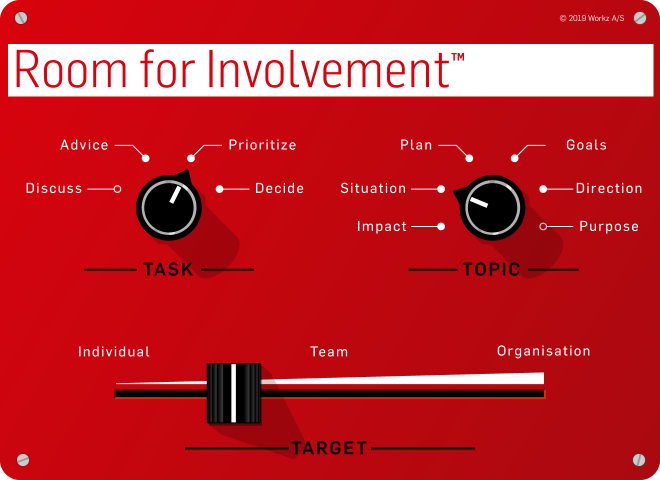"We want to become the most bike-friendly city in Denmark. Send us your input, tell us what we should focus on and we will send you a pdf with the strategy we have developed".
This, more or less, were the words on a poster I spotted a few years back. It made me wonder why the project team behind this message were asking for input if the strategy was already in place? It seemed like a dishonest attempt to involve the audience, but it might also be the result of poor planning.
At Workz, we specialize in involvement because we believe that it is a powerful way of making change that matters. Whether we are helping our clients reach out to employees, users or citizens, one of our first tasks is always to identify what we call the room for involvement. In this room, honesty is crucial because you are asking people to put themselves on the line.
For many people this can be a quite intimidating, and in our experience the most counter-productive mechanisms are dishonesty and, just as bad, shallow involvement.
For instance, a project team might be afraid to ask for input on their work. The decision-making process might be political or the subject matter sensitive. The current stage of the project may have taken the team a long time to reach and they are afraid of set-backs; or they might believe that the complexity of their project is not fit for involvement. Whatever the reason, this causes the team to hold back and only ask trivial questions. Doing this is almost as bad as dishonesty. Shallow involvement is a waste of time and brainpower.
The room for involvement lies somewhere between being honest about your involvement and giving as much influence to the participants as you can. Involvement outside this room will harm the most valuable resource in any organization; trust.
The room for involvement
The room for involvement is the space where the organizers - the people managing the involvement process - can ask questions without being afraid of the answers, where they are genuinely interested in feedback and have confidence in their own ability to act on the input coming their way.
This means; don't promise influence beyond your mandate. Don't ask for input you won't use. It is better to dial down the level of involvement and be honest about your intentions.
Creating room for involvement is done by choosing the right task, by selecting the subject matter of the involvement, and by involving the right people.

Task
First look at the task you give people. This sets the level of influence you offer them over the subject matter. The nature of the task sets the expectations as to how you will act on the input from the participants. Is this a brainstorm, a discussion or a time to make decisions?
The highest level of influence is when you ask the participants to decide something downright. As this will set the expectation that you respect their choice, it is a good idea to forecast possible outcomes before you commit to this level of influence. If you wish to leave yourself some room to operate, it is a good idea to ask the participants to choose between or prioritize a number of options already vetted by you.
The lower levels of influence are when you ask the participants to give input and advice. In this case they will expect you to listen and take their input into consideration, but not necessarily to act on it. However, no matter the nature of the input, always respond to thoughts and contributions. Even if you end up not following advice, use it as a communication opportunity. The people who gave you the input are probably not the only ones feeling that way.
The seemingly least influential thing is to simply give people the opportunity to discuss a topic. Even though you are not asking them for input, a good dialogue can be a powerful trigger for change. Asking for specific input might be just a way to get the discussion going. The most powerful thing coming out of an involvement workshop might be having the right people talk to each other about something they would not talk about if it had not been for you.
Topic
The second dimension is the topic on the table or subject of the involvement. The more upstream you are in a decision process, the more influence you offer the participants. Do they have a say in setting a direction, in planning how to get there, or merely in describing the impact?
The most influence lies in the questions of purpose and meaning (the Why). These are also topics of a magnitude that lends itself badly to direct influence. When dealing with subjects like this you should usually only ask for ideas, inspiration or discussions. On the other hand, these topics often have less direct influence on people’s lives so in that sense they may feel safe to deal with.
Involving people in setting the direction (the What) is maybe the most potent topic to deal with. The direction usually has the biggest impact on an organization. For the same reason it is rare that you can offer direct influence unless you are involving a very powerful group of people.
Setting goals and targets are the next step down in level of involvement. When you ask people to set goals you are not asking them in what direction to move, but how far you should aim for. How you frame the question also matters. There is a big difference between asking for ambitious goals and setting realistic targets.
Planning how to get there (the How) is the topic closest to most participants. Instead of having them define the purpose of their activities, you are asking them to describe or plan their own work. Presenting a strategy and then having the people who will be carrying it out brief back to you, how they plan to do it, is a powerful kind of involvement. This is called back-brief and Ask Agger has written an article on it.
The least influential topic is the impact and consequences of a decision, strategy or plan. On this level you ask for input on what the participants think will be the result of doing something.
This can be surprisingly effective way (and maybe the only one) of dealing with unpopular changes. Even though decisions have been made and things will change, you can involve people in discussing and sharing the impact it will have on their own lives. The input you get can help you to best mitigate negative effects.
Target
The final thing to decide when planning your involvement is the scope. Are you inviting a few people to talk about themselves or is it a broad involvement of everybody in the organization?
A narrow scope is when you only ask a few people and the topic has to do with themselves or their teams. A wider scope can be reached both by extending an invitation to everybody; or by having the people you involve talk on the behalf of others than just themselves.
Usually, it is most effective to involve people in their own affairs. But sometimes it does make sense to ask for input on how the participants think other people will react or the consequences they assess a change will have on others. Management, on the other hand, is by nature typically involved on behalf of other people, but sometimes you want to involve them as individuals.
Widen the scope to have a big impact with your involvement. Limit the scope to reduce the risk if the subject matter is sensitive or you are unsure about how people will react. You can always widen the scope later on.
Do not, however, think that the effect of the involvement is limited to the group invited. Both positive and negative effects can spill over. Sometimes just being invited (or not) can have an effect on its own.
Involving from trust
When creating room for involvement, keep these three parameters in mind and adjust them to fit the task at hand. This will help you clarify at what stage in the decision-making process you want to involve people, what level of influence you will offer them, and finally, if you involve them in matters relating to themselves only or ask for input on a wider scope.
When it comes to trust, you have got to give it away in order to receive it. You have to involve from trust, not just for trust.
Start by having faith in the people you involve and build your involvement from this place. Stay in the honest room for involvement, and do not be afraid to ask for feedback and take all the input you get seriously.
This is the path to building trust. Ask writes more about this philosophy in his latest article; Leading from trust.


